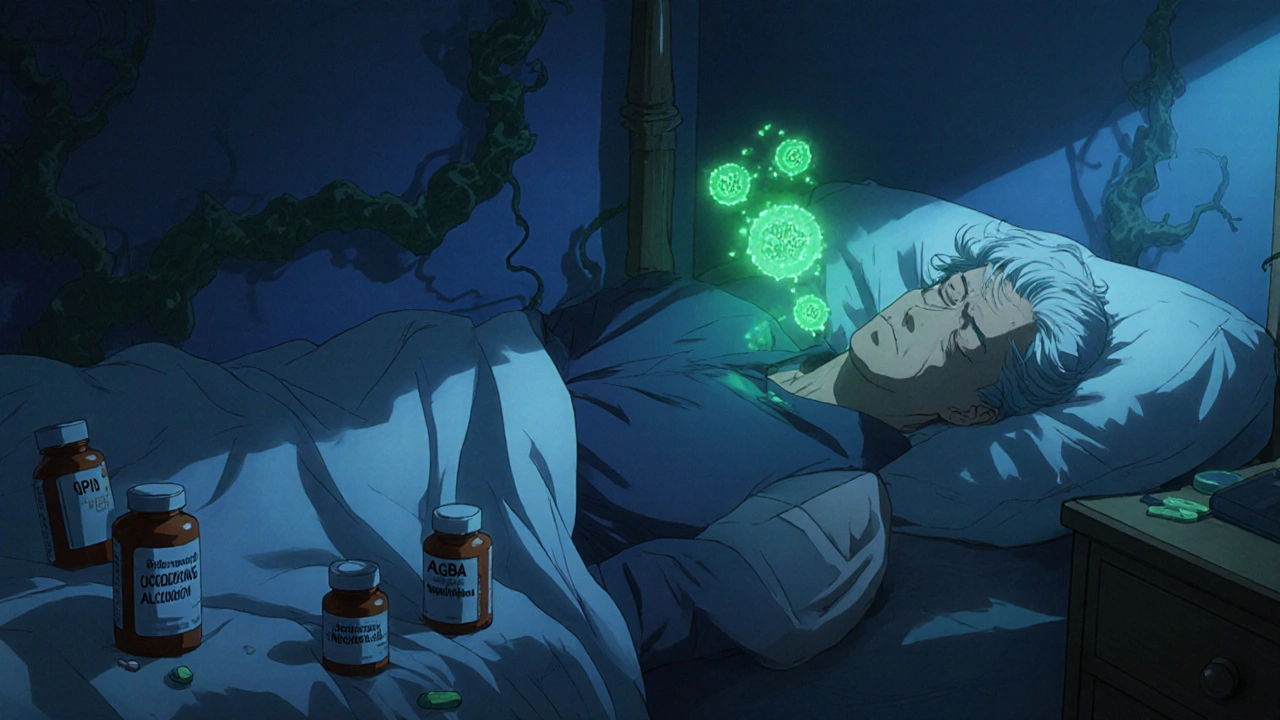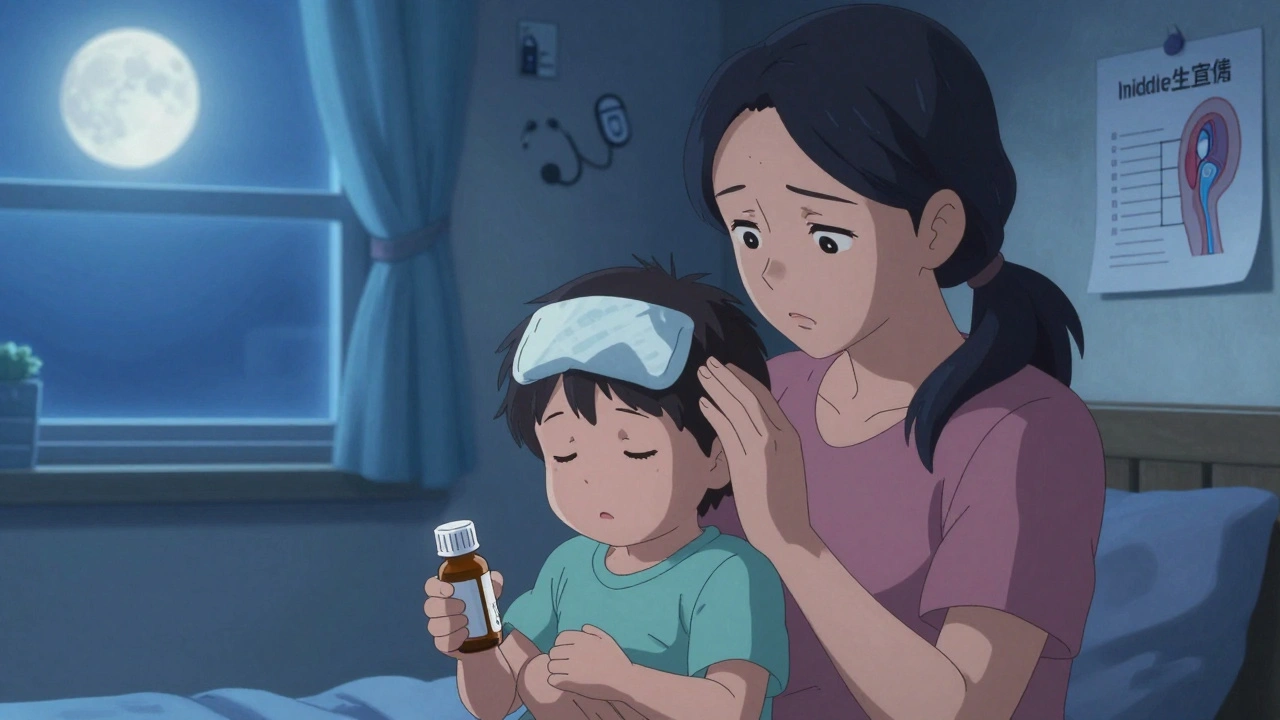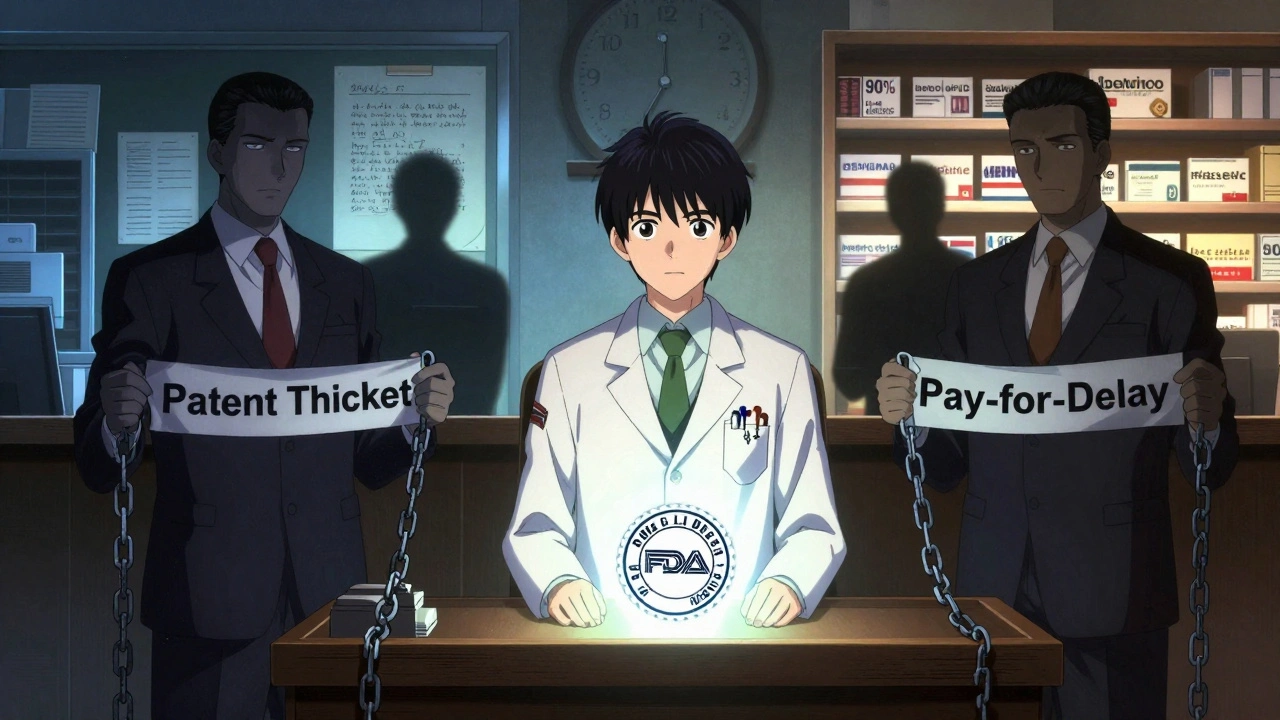CNS Depression Risk Calculator
How This Works
Enter your current medications to see if your combination poses dangerous CNS depression risks. Based on FDA guidelines and clinical research, this tool identifies high-risk combinations and provides actionable steps.
Your CNS Depression Risk Assessment
Risk Level:
Identified Risks
Recommended Actions
Important Medical Information
Urgent Note: If you experience extreme drowsiness, slow breathing (fewer than 10 breaths/minute), confusion, or difficulty waking up, call emergency services immediately.
It’s not uncommon for people to take more than one medication to manage pain, anxiety, or sleep issues. But when those medications are all sedatives-like opioids, benzodiazepines, sleep pills, or even alcohol-their effects don’t just add up. They multiply. And that’s when things turn deadly.
What Happens When Sedatives Mix?
Central nervous system (CNS) depressants work by boosting GABA, a brain chemical that slows down nerve activity. Think of it like hitting the brakes on your brain. One sedative might make you drowsy. Two? You might struggle to stay awake. Three? Your breathing could slow to a dangerous crawl.
The most dangerous combo? Opioids and benzodiazepines. The FDA warned in 2016 that mixing these two increases the risk of fatal overdose by 2.5 to 4.5 times compared to using opioids alone. Why? Both drugs suppress the brainstem-the part that controls breathing. When they team up, your body stops signaling you to breathe. Oxygen levels drop. Within minutes, brain damage can start. In 15 to 20 minutes, oxygen saturation can fall below 85%. That’s a medical emergency.
It’s not just prescription drugs. Alcohol is a CNS depressant too. Many people don’t realize that having a drink with their sleeping pill or painkiller is just as risky as mixing two pills. A 2012 study found that 12-13% of people on chronic opioid therapy drank alcohol within two hours of taking their dose. That’s not casual-it’s a ticking clock.
Who’s at the Highest Risk?
It’s not just about what you take-it’s who you are.
Elderly patients are especially vulnerable. Their bodies process drugs slower. Their brains are more sensitive. A 2023 study showed that older adults on three or more CNS depressants had a 45% higher chance of being hospitalized for a fall. And falls in older people aren’t just bruises-they lead to broken hips, long recoveries, and sometimes death.
People with depression or substance use disorders are also at higher risk. The same 2012 study found that those with a history of substance use were 39% more likely to mix sedatives than those without. Depression doubles the odds of dangerous polypharmacy. Why? Because both conditions often come with insomnia, anxiety, and chronic pain-and doctors may prescribe multiple meds without fully connecting the dots.
Women are more likely than men to be prescribed these combinations. One study found a 1.7 times higher risk. That’s not because women are more prone to misuse-it’s because they’re more likely to be prescribed anxiety or sleep meds in the first place.

The Silent Long-Term Damage
Most people worry about the immediate danger-overdose, coma, death. But the long-term effects are just as damaging, and often ignored.
Chronic use of multiple sedatives leads to:
- Chronic fatigue (45% of long-term users)
- Weight gain of 12-18 pounds over a year
- Sleep apnea (27% of users)
- Sexual dysfunction (32%)
- Depression (38%)
- Suicidal thoughts (19% after six months)
These aren’t side effects-they’re consequences. The brain gets used to being slowed down. It stops producing natural calming chemicals. When you try to cut back, your nervous system goes into overdrive. That’s why dependence turns into addiction so easily.
And then there’s cognitive decline. A 2009 study tracked elderly patients on multiple CNS depressants and found a 27% higher risk of significant mental decline-measured by a 5-point drop on a standard memory test. That’s not normal aging. That’s drug-induced.
What You Should Do
If you’re on more than one sedative, you need to talk to your doctor-not just once, but regularly. Here’s what to ask:
- Is this combination absolutely necessary?
- Can any of these meds be replaced with something safer?
- Are there non-drug options for my sleep, anxiety, or pain?
- What are the signs I should watch for that mean I’m in danger?
Many people don’t realize their meds are risky because they’re prescribed by different doctors. One prescribes the opioid for back pain. Another prescribes the Xanax for anxiety. No one connects the dots. That’s why medication reviews are critical. Every 3-6 months, bring a full list of everything you take-prescriptions, supplements, even over-the-counter sleep aids-to one provider. Ask them to map it all out.
Deprescribing-gradually reducing or stopping meds-is proven to work. Studies show that when done properly, it cuts fall risk by 32% and cognitive decline by 27%. But it has to be done slowly, under supervision. Stopping cold turkey can cause seizures, hallucinations, or rebound anxiety.

What’s Being Done to Fix This?
Health systems are starting to wake up. The FDA now requires strong warning labels on opioid and benzodiazepine packaging. The CDC advised doctors in 2016 to avoid prescribing these drugs together-and since then, co-prescribing dropped by 15%.
But the problem isn’t gone. In 2020, over 10% of people on long-term opioids were still getting benzodiazepines too. Why? Because some doctors still think, “It’s just one more pill.” It’s not. It’s a loaded gun.
New tools are emerging. Electronic health records are being updated with automatic alerts when a doctor tries to prescribe a dangerous combo. In pilot programs, these alerts reduced risky prescriptions by 28%. By 2025, most major systems will have them built in.
Some clinics are now using genetic testing to see how patients metabolize drugs. If you have a slow CYP450 enzyme variant, your body can’t clear sedatives fast enough. That makes even normal doses dangerous. Early data shows testing can cut risky combinations by 22% in high-risk groups.
What You Can Do Right Now
You don’t have to wait for your doctor’s appointment. Start today:
- Write down every medication, supplement, and substance you take-including alcohol and cannabis.
- Check the labels. Look for warnings like “May cause drowsiness,” “Avoid alcohol,” or “May interact with CNS depressants.”
- If you’re taking more than one sedative, don’t stop abruptly. Call your doctor and ask for a safety plan.
- Keep a journal: note when you feel extra sleepy, dizzy, or confused. Bring it to your next visit.
- If you live alone, tell someone you trust about your meds. Ask them to check on you if you seem unusually drowsy.
There’s no shame in needing help. But there’s real danger in silence. The goal isn’t to stop all meds-it’s to stop the ones that are putting you at risk.
Can mixing alcohol with sleep pills be deadly?
Yes. Alcohol is a CNS depressant, and combining it with sleep pills like zolpidem or benzodiazepines can slow your breathing to dangerous levels-even at low doses. Emergency rooms see this combo regularly. It’s one of the most common causes of accidental overdose in people over 50.
Is it safe to take an opioid for pain and a benzodiazepine for anxiety?
No. The FDA and CDC strongly advise against this combination. Even if you’ve taken them separately without issues, together they can shut down your breathing. There are safer alternatives for anxiety, like therapy, SSRIs (with caution), or non-addictive muscle relaxants. Talk to your doctor about switching.
What are the signs I’m experiencing CNS depression?
Look for: extreme drowsiness, slurred speech, confusion, slow or shallow breathing (fewer than 10 breaths per minute), dizziness, unsteady walking, or inability to wake up. If you or someone else shows these signs, call emergency services immediately. Don’t wait.
Can I just reduce my dose instead of stopping completely?
Reducing dose is often the right first step-but it must be done under medical supervision. Stopping suddenly can cause seizures, hallucinations, or rebound anxiety. A doctor can create a tapering plan that lowers your dose slowly over weeks or months to avoid withdrawal and keep you safe.
Are there non-drug alternatives to sedatives for sleep or anxiety?
Yes. For sleep: cognitive behavioral therapy for insomnia (CBT-I) is more effective long-term than sleeping pills. For anxiety: mindfulness, regular exercise, and therapy (like CBT) work better than benzodiazepines without the risk of dependence. Even simple changes-cutting caffeine after noon, keeping a consistent sleep schedule, or using a white noise machine-can make a big difference.






Kane Ren
November 23, 2025 AT 17:22Man, I never realized how sneaky this stuff is. I thought if my doctor prescribed it, it was fine. Turns out, I was mixing my pain meds with a glass of wine at night like it was no big deal. Thanks for laying this out so clearly - I’m scheduling a med review this week.
Still feel kinda guilty, but also relieved I caught this before something bad happened.
Charmaine Barcelon
November 25, 2025 AT 16:59You’re lucky you’re alive. Seriously. Mixing alcohol and sleeping pills? That’s not a mistake - that’s a death wish. And don’t even get me started on people who think ‘just one pill’ is harmless. You’re not special. You’re not immune. You’re just a statistic waiting to happen.
John Mackaill
November 25, 2025 AT 20:30This is one of those topics that gets buried under stigma and silence. I’ve seen friends lose years of their lives to this - not because they were addicts, but because they were just trying to sleep, or manage anxiety, or deal with chronic pain.
The system fails people here. Doctors are overworked. Patients are scared to speak up. And no one talks about the slow erosion - the fatigue, the weight gain, the foggy brain - until it’s too late.
Thank you for writing this. It’s not just medical advice. It’s a lifeline.
Adrian Rios
November 26, 2025 AT 01:12I’m a nurse, and I’ve seen this play out a hundred times. A 72-year-old woman on three different sedatives - one for pain, one for anxiety, one for sleep - and she’s been taking a beer with dinner every night for 20 years. No one ever asked her about it. No one ever connected the dots.
When she fell and broke her hip, they blamed ‘old age.’ But it wasn’t age. It was polypharmacy. It was silence. It was the fact that three different doctors gave her meds without ever talking to each other.
Deprescribing isn’t about taking things away - it’s about giving people back their lives. I’ve watched people regain their balance, their memory, their joy - after we slowly weaned them off the cocktail.
And yes, it’s scary. But so is dying in your sleep because your brain forgot how to tell your lungs to breathe.
Please, if you’re reading this and you’re on more than one sedative - don’t wait for a crisis. Talk to someone. Bring your list. Ask the hard questions. You deserve to be safe.
And if you’re a doctor reading this - stop prescribing in silos. Start asking: ‘What else is this patient taking?’
Casper van Hoof
November 26, 2025 AT 13:20The pharmacological synergy of CNS depressants represents a profound bioethical quandary in contemporary clinical practice. The confluence of GABAergic potentiation and mu-opioid receptor activation induces a non-linear decrement in respiratory drive, a phenomenon quantitatively documented in the literature since the 1990s.
Moreover, the sociological dimension of polypharmacy in aging populations reveals a systemic failure of interprofessional communication, wherein the fragmentation of care pathways permits iatrogenic harm to proliferate under the guise of therapeutic intent.
It is not merely a matter of individual risk mitigation, but of institutional accountability and the reconfiguration of clinical workflows to prioritize harm reduction over symptom suppression.
Richard Wöhrl
November 27, 2025 AT 11:00Just a quick heads-up - if you’re on any of these meds, check your labels for the word ‘CNS depressant’ - it’s usually right there in small print. Also, don’t forget over-the-counter stuff like diphenhydramine (Benadryl) or melatonin - they’re not harmless either, especially with alcohol or opioids.
And if you’re feeling more tired than usual, or dizzy when you stand up, or confused after taking your meds - write it down. Don’t assume it’s ‘just aging.’ That’s the first step to getting help.
I’ve helped people cut down on their meds, and the difference? They start laughing again. They remember names. They walk without a cane. It’s not magic - it’s just stopping the slow poison.
And yes, it’s scary to stop. But it’s scarier to keep going without knowing you’re on the edge.
Brandy Walley
November 27, 2025 AT 21:58shreyas yashas
November 28, 2025 AT 15:52Bro, I’m from India, and here, people mix sleeping pills with whiskey like it’s chai. No one talks about it. My uncle did this for years - said he ‘needed it to sleep.’ Last year, he stopped breathing in his sleep. Got lucky, survived.
Now I tell everyone I know: if you’re taking more than one thing to calm down or sleep - you’re already in danger. Don’t wait for the hospital to tell you.
Write it down. Talk to your doctor. Even if they’re busy. Your life matters more than their 10-minute visit.